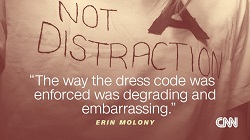If you’re just tuning in, this is the final blog of a three-part series. Dress Code Season Part 1 introduces dress codes and explained why more schools are adopting them. Part 2 describes several of the problems associated with dress codes, and this blog, Part 3, identifies action-oriented dress code solutions to those problems.
It’s easy to list a litany of reasons why school dress codes don’t work for everyone; the challenge is identifying a real, tangible solution that can be implemented with success. The chart below reviews many of the problems associated with dress codes, but goes one step further, suggesting ways and actionable steps to help these codes work for everyone.
Dress Code Problems |
Dress Code Solutions |
| They are usually overly prescriptive of clothing worn by girls and pay less attention to clothing worn by boys. | Instead, ensure the equal rights of all students to have a quality education by having dress code rules that apply equally to students of all genders. |
| They shame girls for their developing bodies at a time when they are just getting used to the changes that occur during puberty. | Support students in embracing their development at all stages by applying dress code rules to all students without regard to their stage of physical development. |
| They sexualize underage children by interpreting certain clothing and appearances as “sexy” and therefore, inappropriate. | Instead, recognize that clothing choices are a way to express identity, and encourage identity formation that doesn’t self-objectify through clothing choices. |
| They develop or reinforce the attitude that girls are responsible for male sexual responses, unwanted sexual attention, and sexual harassment. | Teach boys how to respectfully manage their own responses by teaching them relationship skills, including respectful communication, maintaining personal space, and consent. |
| They focus on trying to prevent distractions to the people around the student. They tell girls, “You are distracting the boys because your leggings are too tight…dress is too short…bra straps are showing, etc.” | Teach students how to select comfortable clothing that will not distract them from their own learning due to creating discomfort, limiting range of motion, or needing repeated adjustments. |
| They assign stereotypical gender-based clothing standards. | Instead, respect individual gender expression by enforcing dress code rules without bias based on the perceived gender of individual students. |
| They are unfriendly, insensitive, or downright traumatic for youth who are gender-fluid, transgender, or questioning. | Ensure that all students are safe, respected, and supported by enforcing dress codes in a manner that is not influenced by gender. |
| They penalize families with limited financial resources. | Maintain a clothing closet of donated items from which families may select and provide a list of places to acquire low-cost clothing for children. |
| They ignore cultural influences on clothing choices. | Meet with families to describe the dress code rules and discuss ways to avoid violations. |
| The consequences for violating dress codes are often shaming and interfere in the student’s educational participation. | Offer respectful instruction about clothing choices that fit the dress code in a way that does not shame students or remove them from their classes. |

Updating the School Dress Code
Now that we have explored the many pitfalls and problems that can come with having a school dress code, you are ready to implement some of the solutions. Follow these six steps to start making positive changes within your own school.
- Take a hard look at your current dress code. Review it for obvious problems, such as rules that are subjective, sexist, racist, or disproportionately target some groups of students. Review the records of dress code violations. Search for patterns. Are some students being “dress-coded” more than others? Are some staff reporting more violations than others? Are the consequences being applied fairly and respectfully?
- Convene a group of stakeholders to discuss the dress code. Include a cross-section of students, parents, and staff. Invite students to participate who are often “dress-coded,” such as female students, LGBTQ students, and students of all races and ethnicities. Consider doing a survey to gather ideas from the students, parents, and staff in your school. Interview people from other schools to learn what they have done that works well.
- Update the dress code with input. Incorporate input from all stakeholders. Focus the dress code discussion on creating a positive and productive learning environment by guiding students to dress in a manner that helps them avoid being distracted from learning by their own clothing. Ensure that your school’s dress code treats all students equally and doesn’t place an unequal burden on any group of students, such as female students, LGBTQ students, low-income students, and minority students. Eliminate any dress code rules that sexualize minor children by building on stereotypes about girls’ bodies and gender roles.
- Train adults who are responsible for enforcing the dress code. Ensure that adults do not shame, humiliate, objectify, demoralize, or remove students from their learning environment. Provide professional development for all staff on the school’s method for reporting dress code violations in a way that is equitable, shame-free, and keeps students engaged in learning. Practice identifying and reporting dress code violations using realistic scenarios and role play. Require adults to submit a written description of each dress code violation to create documentation that can be assessed for dress code updates.
- Publicize the dress code. Provide clear and concreted instructions and explanations of the dress code to all students, parents, and staff. Repeat often. Hold meetings with students and parents who might benefit from more discussion about following the dress code because of communication challenges or a history of past dress code violations.
- Monitor and update the dress code annually. Reconvene the dress code stakeholder group at least once a year to review the documented dress code violations. Look for patterns that might indicate that the dress code is targeting certain students or that some adults are enforcing it improperly. Make improvements to the dress code and communicate the changes to students, parents, and staff.
Want to Learn More?
Articles on Dress Codes:
- https://www.theatlantic.com/education/archive/2015/10/school-dress-codes-are-problematic/410962/
- https://www.cnn.com/2016/02/25/living/dress-code-protests-irpt/index.html
- https://www.nytimes.com/2018/04/17/style/student-bra-nipples-school.html
Laws and Dress Code:
- https://education.findlaw.com/student-rights/school-dress-codes.html
- https://scholarship.richmond.edu/cgi/viewcontent.cgi?article=2275&context=law-faculty-publications
Model Dress Code:
- https://www.eths.k12.il.us/site/Default.aspx?PageID=1381
- http://noworegon.org/wp-content/uploads/sites/12/2018/01/or_now_model_student_dress_code_feb_2016__1_.pdf
Help students learn healthy relationships skills by teaching Puberty: The Wonder Years to students in grades 4, 5, and 6. Learning how to respect others, communicate clearly, and ask for help when it’s needed are skills that will help young people during puberty… and throughout life.
Sign up to try a FREE sample lesson to see what Puberty: The Wonder Years is all about.
Updated 2022-7-24



